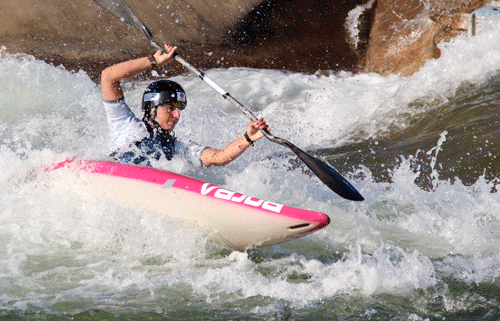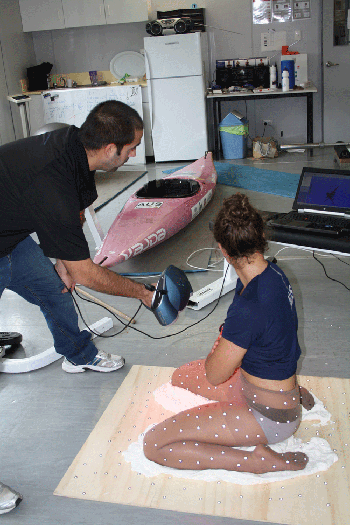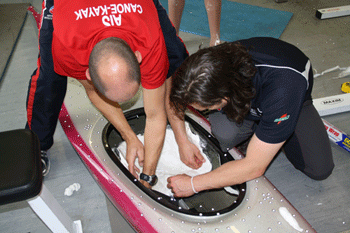A variety of products and technologies were used to create form-fitting kayak seats.
Olympic teams often use the study of athletic biomechanics to gain competitive advantage. The Australian Institute of Sport (AIS) recently turned to 3D scanning technology to create a better “fitout” of kayakers in Olympic canoe slalom.

“Fitout” means building custom parts of foam and wood for the seat of the kayak. It sounds like a simple matter of measurement and cushioning, but in the slalom, fitout gives the competitors an especially crucial edge. In the event, paddlers have to maneuver through 18-25 gates as fast as possible. The tough parts are the segments that are upstream. To propel against the whitewater, the paddle, kayaker, and canoe have to act together as one. To reinvent fitout, biomechanist Ami Drory turned to 3D scanning technology.
“The transfer forces applied through the paddle is a primary determinant of success,” explains Drory. “A good fitout allows the athlete to use their full range of motion while transferring as much force as possible into the water.”

Automated measurements for better fit
Past methods of fitout have been laborious and the results are not easily repeatable. “There can be a frustrating process of trial and error and wasted material before you get it right,” Drury says.
Tasked with about a dozen customizations in a limited time window, he decided to explore an automated process for fitout. His goal was to develop a reliable and repeatable series of digital procedures that would start with real forms of boat and athlete and end with manufactured parts.
The first step was to accurately scan the athlete in position. AIS owned its own 3D laser scanner for use on other sports equipment design, but Drury says the device was insufficient for the project because of the amount of detailed surfacing required in each customization. To handle such a large set of geometric data, he enlisted the help of a Canadian, Sébastien Dubois, an application specialist from the Quebec City-based scanner developer Creaform.
Dubois brought one of Creaform’s portable handheld laser scanners, the REVscan, to the AIS facility in Brane, Australia. The REVscan is a lightweight handheld 3D scanner weighing just 2.1 lbs., with a resolution of 0.004 inches, and an accuracy of 0.05 inches. Used at a standoff distance of up to 12 inches, this scanner is designed for accurate, close-in work, good for organic shapes such as human bodies, and generates industrial level accuracy results.

Scanning kayaker Jessica Fox in position wearing a webbing of point markers, Dubois and Drory created the initial digital test model. The scanning equipment, featuring TRUaccuracy technology mapped 3,500,000 polygons-worth of 3D points in about an hour. Another thorough two-hour scan captured the interior of Fox’s competition kayak. (Image left: Creating a clay impression of the inside of the kayak for scanning into 3D.)
Using Creaform’s VXelements software, Dubois produced STL polygonal data files of the scans which were imported into Geomagic Studio, for processing of almost every kind of 3D data into precise NURBS surfaces for use in CAD. Both Fox’s body scan and the kayak scan were processed through Geomagic’s system where they could be saved as IGES data for import into SolidWorks. Once in the CAD system, Boolean operations on the data could be used to enable precise modeling of the kayak fitout, customized perfectly to the athlete’s unique body shape. Using this process, Dubois scanned and processed 11 athletes’ scans in 3 days.

Changing what is possible
Whether or not Fox and the other Australians win medals in London, Drory is confident that the improvements in fit will at very least shave some time off the clock, giving the athlete’s a better chance to achieve their best times.
“This project was a fast and efficient workflow from measurement to manufacturing that is individualized for each athlete,” says Drory, “The optimal boat fitout for each athlete may have a significant positive impact on the performance and success of those athletes in the 2012 London Olympics.”





